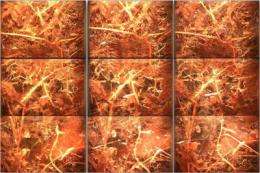Method of studying roots rarely used in wetlands improves ecosystem research

A method of monitoring roots rarely used in wetlands will help Oak Ridge National Laboratory researchers effectively study the response of a high-carbon ecosystem to elevated temperatures and levels of carbon dioxide.
Colleen Iversen, ORNL ecosystem ecologist, and an international group of experts, worked to develop a consensus on the use of minirhizotrons, or tiny video cameras that take images of roots, in wetlands. Minirhizotrons are an improvement over previous technology because they don't harm the plants and allow researchers to examine a living root in the context of a soil environment.
"One of the benefits of minirhizotron technology is the ability to track the birth and death of individual roots," said Iversen. "Root activity is integral to plant survival in wetlands that store a substantial amount of carbon in deep soil organic matter deposits but have limited nutrients available for plant uptake and use."
Ultimately, the minirhizotrons will be placed in a black spruce bog in Minnesota, the site for the multi-year experiment SPRUCE, or Spruce and Peatland Responses Under Climatic and Environmental Change. Chambers placed in the site will allow researchers to manipulate air and soil temperatures and levels of carbon dioxide in an intact bog – a wetland that accumulates a deposit of dead plant material.
Understanding and improving the capabilities of these mini cameras will help the SPRUCE researchers study fine roots, which are responsible for plant water and nutrient uptake.
"Minirhizotrons are the best way to get at the dynamics of this short-lived and important root population, especially in a long-term experiment like SPRUCE where we can't be too destructive in our soil measurements," Iversen said.
One of the reasons scientists are interested in high-carbon ecosystems like the Minnesota bog is because they cover only three percent of global land surface, but store nearly one-third of terrestrial carbon. If the planet continues to warm, researchers hypothesize that bogs will dry out and more oxygen will be made available for microbial decomposition, which could lead to a massive release of carbon into the atmosphere, resulting in more warming.
Additionally, more precise studies of roots will help researchers effectively model roots and be able to better predict what role they will play in nutrient cycling and storing carbon belowground.
More information: The paper, titled "Advancing the use of minirhizotrons in wetlands," was published recently in Plant and Soil.
Provided by Oak Ridge National Laboratory















